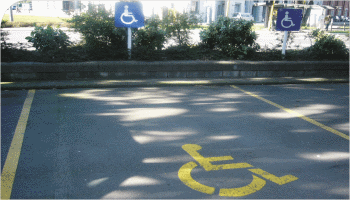The need for accessible car parking
Most people with impaired mobility depend on the use of a privately owned motor vehicle or a designated maxi-taxi with a hoist for their transport needs. Both forms of transport are essential to enable them to participate fully in the everyday working, recreational, educational and social life of the community.
Many wheelchair users are able to drive a car. The wheelchair is carried inside the car or mounted on a roof hoist. However, a wider than normal car parking space is needed so there is room to place the wheelchair along-side the car door and to transfer to it.
A route is also needed from the park to the associated building that a wheelchair user can travel along without assistance (defined as an 'accessible route').
Some public transport has been adapted for wheelchair users but, in practice, the use of public transport on a regular basis is not yet feasible for many wheelchair users or for some people with an ambulatory disability. Apart from the difficulty gaining access to the bus or train itself, there is often a long travel distance at each end of the public transport route.
 A good accessible parking space.
A good accessible parking space.